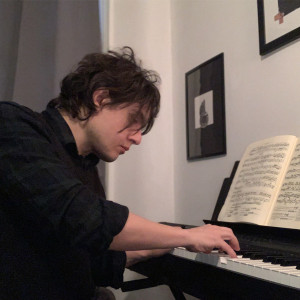Have you always been in love with the jazz piano sound? Or has everyone been telling you how challenging it is to learn jazz piano? Do you worry you won't have Art Tatum's speed and dexterity or that you won't be able to master Thelonious Monk's angular style?
Believe it or not, that's actually the most fascinating part of jazz piano. You don't have to be like anyone, play like anyone or sound like anyone. Jazz is all about improvisation. It's the perfect style of music to let go of your playing inhibitions.
In fact, the sooner you get started with jazz piano for beginners, the better. To help you get started, we'll go over:
- intervals
- 2-5-1 progressions
- 7th chords
- the blues scale
- playing eighth-notes
Before you dive into the world of beginner jazz piano, you need to be familiar with your instrument. You'll need to know your chords and how to read music. That includes identifying chord symbols and notation markings. Consider booking a piano lesson with a private tutor for personalised guidance.
Also, you have to know and understand music theory. If you've got all that under your hat and a real book in your hands, you're ready to start learning jazz piano. Even without a real book, you're ready to go.
Find out about some of the best piano lessons in Belfast here.

Jazz Piano Overview
The most important takeaway about jazz piano is the different styles. Ragtime jazz piano is substantially more upbeat and lively than, say, smooth 'coffeehouse' jazz piano. The latter tends to play in a slower tempo, with lingering notes that call for judicious use of the sustain pedal.
For all its pep or smoothness, jazz piano is sophisticated. You will apply much more music theory, particularly some of its more complex aspects. That should signal you to explore jazz piano stylings as early as possible as you learn to play the piano. That point in your learning curve sees the greatest focus on music theory so playing jazz piano pieces will diversify your piano practice.
Mastering chords and intervals for jazz piano is so important that we've given them their own sections. But fingering and speed are universal, they apply to every genre of music you might play. So let's take a moment to talk about how these aspects of piano playing impact jazz piano. And besides, many piano teachers bemoan students' lack of focus on their fingering so this should help you get on your teacher's good side.
Despite your hands mirroring each other, piano playing has fingering rules specifically for your right and left hands. For instance, when playing flat scales, your right hand's third finger always plays B-flat. Your right hand's thumb would then play C and F.
Your left hand's 'rules' are far more elaborate; they depend on the scale you're playing. But in all cases, your fifth fingers should never cross your thumbs and your fourth finger should cross your thumb only rarely.
Mastering fingering is vital to building the speed you need to play jazz piano. If it takes you five seconds or more to finger the next chord, you need a lot more practice. A part of this problem is uncertainty.
Piano students have a hard time believing that their fingers have already learned where they need to be. Thus, they feel compelled to look at their hands, which inevitably slows down their playing. If you watch any jazz piano videos, you'll note that players seldom look at their hands because they're confident in their fingering.
Find piano lessons in Birmingham here.

Intervals for Easy Jazz Piano
Now, with fingering, arpeggios and scales (as they relate to jazz piano) put in their proper perspective, we can get on with intervals. As you know, an interval is a space between two notes, which represents the way notes relate to each other. That relationship underpins melodic harmony.
Have you mastered intervals? If so, try this exercise. Start with middle C and then, go up the piano at perfect fifth intervals: G, D, A, E, and so on. Ultimately, you'll land on C and if your ear is really in tune, you'll find that these notes are all in harmony.
Now, let's repeat the exercise, but in reverse. Start with the highest C and play your way down the piano at perfect fourth intervals. That sequence goes C, F, Bb, Eb, Ab and so on.
This pattern of perfect fourths and fifths underpins practically every jazz tune. More specifically, jazz scales, chords, chord voicings and licks - melodic patterns, are all interval patterns. If you have the 12 intervals down pat, you should also know how to count tritones, major 3rd, minor 3rd, major 7th, minor 7th and major/minor 6th.
But if you need more time to master counting intervals, you should get more practice in. You need to have a firm grasp on this before we move on to chords in jazz piano. Go ahead; we'll wait for you.

Jazz Piano Chord Progression
Welcome back! Now that you're a master of interval counting, you're ready to tackle chords. In jazz, chords have a unique property, namely that they're nearly all 7th chords. As you thumb through your real book, you'll see that they're easy to recognise because they all end with a 7.
The so-called 7th chord is a standard CEG triad, major or minor, with a 7th (B) on top. C E G B represents C major 7 (C maj 7). C minor 7 would then be C Eb G Bb and C dominant 7 (written C7) is C E G Bb.
These three chords feature in a lot of all jazz piano music. The other three major chords are C half-diminished (C Gb Eb Bb), C diminished (C Eb Gb Bbb) and C minor-major (C Eb G B).
But jazz piano players are a quirky lot. They like to spice things up a bit by playing what's called the 2-5-1 progression - D G C. This piece of music theory features in every jazz tune you've ever heard and all the ones you haven't, too. The C maj 7 chord you just read about is a 2-5-1 progression. G B D F represents the G7 chord and D F A C is the Dm7 chord.
Also, note that the 2-5-1 progression is often written using Roman numerals: ii-v-I. That is most often how you will see this progression written in real books. As you practise these jazz piano chords and progressions, be sure to play all of the chords from each of the 12 notes. But mind your intervals because you'll never get to play any duets with a partner if you don't internalise intervals and chord progressions.
Easy Jazz Piano Songs
Now that you count intervals automatically and have mastered chords and the ii-v-I progression, you'll probably want a few good starter songs to play. Your real book should have a fine selection; tunes from Duke Ellington and probably Dave Brubeck, too. Do you want to sample something beyond your book?
- Try On a Clear Day. It has swing elements woven into its easy, upbeat sound. It includes rather sparkling piano melodies that are so much fun to play and a groovy rhythm section that is downright intoxicating.
- Waltz for Debbie isn't very complex but it's achingly beautiful. Even seasoned jazz piano players return to Waltz time and again because the tune just won't leave them alone. It's also fairly easy to play.
- But nobody ever said you had to cut your teeth on the mild stuff. If you want to challenge your chord progressions, try Herbie Hancock's Dolphin Dance. Like that marine mammal, this song is unpredictable and wild, with occasional slow-downs but a constant in its melody.
- You might follow it up with Round Midnight by Thelonious Monk, just to give your hands a break. It too has a strong melody but it's not as complex as Dolphin Dance.
- If none of these suggestions gets you any closer to the type of jazz piano tunes you want to play, you should aim for the classics. Anything Ella Fitzgerald put her voice to might work for you; our personal favourite is All the Things You Are, with Dream a Little Dream of Me coming in a close second. All the Things incorporates rapid chord progressions to make things a bit challenging while Dream is a bit more laid back.
- Erroll Garner was one of the best jazz piano players and composers of his day. His playing style incorporated the stride playing technique of past piano masters. But he added his own style to render some of the most fluid pieces you can practise playing. If you want to improve your playing's lyrical quality, try your hand at Misty.
- For something with a bit more pep, how about Autumn Leaves? Far from a dreary representation of sodden fallen foliage, it sounds more like crackling brown husks dancing around in the brisk breeze. Joseph Kosma composed this popular jazz standard that every beginner jazz piano player should learn. Not just because it has a lot of chord progressions but simply because it stands for everything you need to know about playing the piano.















